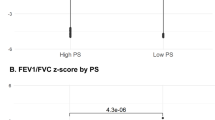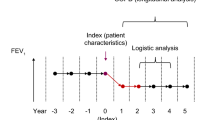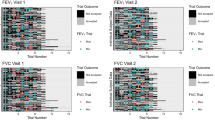Abstract
Aims:
To determine the agreement between the FEV1/FEV6 ratio and the FEV1/FVC ratio in an elderly population.
Method:
The study sample consisted of 3874 participants in a cross-sectional population survey in Tromso¨, Norway, aged 60 years or more, in whom acceptable spirometry had been obtained. Mean differences between the FEV1/FEV6 ratio (%) and the FEV1/FVC ratio (%) were calculated according to age, sex, smoking habit, and the degree of airflow limitation. ROC-curve analysis and Kappa-statistics were used to estimate the utility of the FEV1/FEV6 ratio in predicting an FEV1/FVC ratio< 70%.
Results:
The mean difference between FEV1/FEV6% and FEV1/FVC% was 2.7% in both men and women. The difference between the two measures increased somewhat with increasing age, and was more pronounced with smoking and decreasing FEV1/FVC ratio. The value for the FEV1/FEV6 ratio which best predicted an FEV1/FVC ratio of 70%, was 73%, and a very good agreement was found between these two cutoff values (kappa = 0.86).
Conclusion:
The FEV1/FEV6 ratio appears to be a good substitute for the FEV1/FVC ratio in an elderly population.
Similar content being viewed by others
Article PDF
Author information
Authors and Affiliations
Corresponding author
Rights and permissions
About this article
Cite this article
Melbye, H., Medbø, A. & Crockett, A. The FEV1/FEV6 ratio is a good substitute for the FEV1/FVC ratio in the elderly. Prim Care Respir J 15, 294–298 (2006). https://doi.org/10.1016/j.pcrj.2006.07.002
Received:
Accepted:
Issue date:
DOI: https://doi.org/10.1016/j.pcrj.2006.07.002
This article is cited by
-
Accuracy of Vitalograph lung monitor as a screening test for COPD in primary care
npj Primary Care Respiratory Medicine (2020)
-
Peak flow meter with a questionnaire and mini-spirometer to help detect asthma and COPD in real-life clinical practice: a cross-sectional study
npj Primary Care Respiratory Medicine (2017)
-
Predictors of poor-quality spirometry in two cohorts of older adults in Russia and Belgium: a cross-sectional study
npj Primary Care Respiratory Medicine (2015)
-
Diagnostic accuracy of pre-bronchodilator FEV1/FEV6 from microspirometry to detect airflow obstruction in primary care: a randomised cross-sectional study
npj Primary Care Respiratory Medicine (2014)
-
Efficient screening for COPD using three steps: a cross-sectional study in Mexico City
npj Primary Care Respiratory Medicine (2014)



